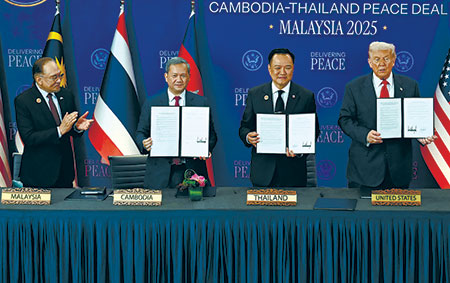
President Donald Trump’s initial foray into his Asia tour has quickly cemented his self-proclaimed image as a global peacemaker. Touching down in Malaysia’s capital, Kuala Lumpur, Trump presided over the signing of a peace agreement between Thailand and Cambodia, a conflict that had displaced hundreds of thousands and claimed dozens of lives just months prior in July. This highly publicized event has set a dramatic tone for the remainder of his high-stakes diplomatic marathon across the continent.
The ceremony, however, was quickly overshadowed by conflicting narratives surrounding the mediation efforts. While Bangkok had previously maintained that the peace was achieved without external intermediaries, Trump swiftly claimed credit, asserting his pivotal role in brokering the accord and securing the release of Cambodian prisoners. Malaysian Prime Minister Anwar Ibrahim further fueled the narrative of Trump’s unconventional style, recounting an impromptu invitation to join the U.S. President in his limousine directly from the airport tarmac, bypassing traditional protocol.
Yet, beyond the immediate fanfare of peace deals, the White House agenda for the remainder of Trump’s tour includes more ‘prosaic’ but equally crucial trade negotiations with both Cambodia and Thailand. According to The New York Times, these dual pillars—peace and trade—form the cornerstone of Trump’s multilateral engagements. The quest for U.S. favor was evident, with Cambodian Prime Minister Hun Manet going as far as to publicly call for Trump to be awarded the Nobel Peace Prize, a suggestion that the Norwegian Nobel Committee has not acknowledged. Thailand, in contrast, offered a more measured response, merely stating that a trade agreement with the U.S. and discussions regarding rare-earth metal extraction were anticipated by year-end.
Throughout his speeches in Malaysia, Trump reiterated his long-held critiques of the United Nations, arguing that the global body had failed to intervene effectively in the Thai-Cambodian conflict. He also asserted that his return to the White House has seen him resolve eight international conflicts, though The New York Times notes that while his role in the Israel-Hamas ceasefire was clear, his involvement in other claimed resolutions remains less substantiated or acknowledged by international observers.
Trump’s diplomatic mission in Malaysia extends beyond bilateral talks with Thailand and Cambodia, encompassing broader discussions with members of the Association of Southeast Asian Nations (ASEAN). His journey will also see him engage with Brazilian President Luiz Inácio Lula da Silva, a meeting anticipated to be fraught with disagreements, particularly concerning trade tariffs imposed by Trump in an attempt to influence Brazil’s domestic actions against former President Jair Bolsonaro.
Looking ahead, the geopolitical stakes escalate as Trump prepares for a potentially even more significant encounter: a meeting with Chinese President Xi Jinping. U.S. Trade Representative Jamison Greer offered a cautiously optimistic, yet ambiguous, outlook, stating that the two nations are moving towards “final details of an agreement that leaders can review and then decide if they want to conclude.” U.S. Treasury Secretary Scott Bessent is currently in Kuala Lumpur, spearheading these sensitive negotiations with his Chinese counterparts.
The U.S. President also signaled his openness to another historic meeting with North Korean leader Kim Jong Un, rekindling a dialogue that began over six years ago with a quickly arranged spectacle at the inter-Korean border. Trump is scheduled for a state visit to South Korea this week to meet President Lee Jae-myung and attend the Asia-Pacific Economic Cooperation (APEC) summit. However, the certainty of a renewed Trump-Kim summit, or even a direct Trump-Xi conversation at APEC, remains notably elusive.
Amidst these high-level diplomatic maneuvers, a significant regional development unfolded: East Timor, the youngest independent nation in Southeast Asia, formally joined ASEAN. For the 1.4 million-strong nation with a modest $2 billion GDP, its inclusion marks a historic moment, the first new member since the 1990s. Prime Minister Xanana Gusmão hailed the occasion, emphasizing the potential for economic growth by integrating into a bloc boasting a combined GDP of $3.8 trillion. Malaysian expert Angelina Tan suggested that welcoming a small, developing nation like East Timor underscores ASEAN’s visionary leadership and commitment to regional stability and cooperation amid current global turbulence.
